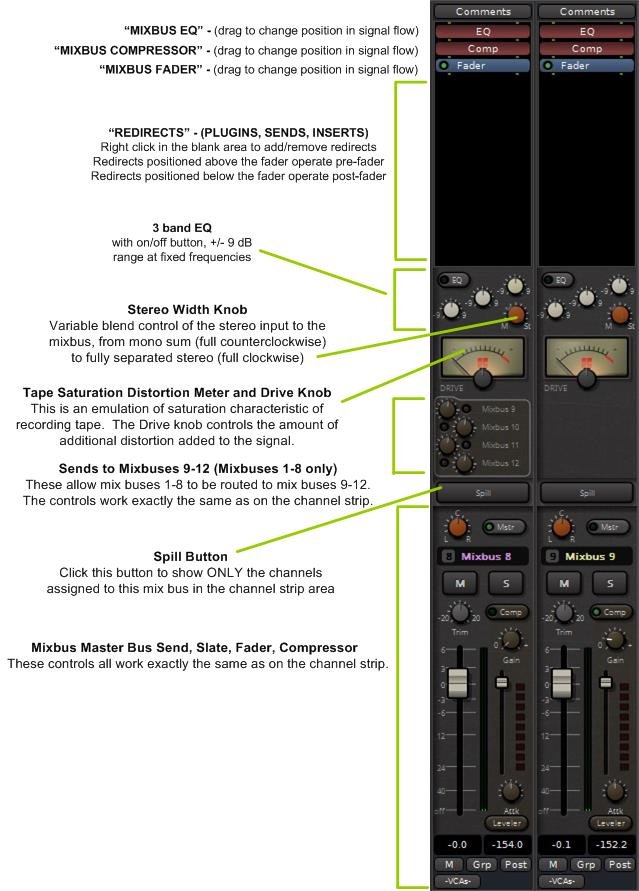There are 12 “mixbus” channels. All 12 are fed from the mix bus sends of the input channels. Additionally, mix buses 9-12 can be fed from the outputs of mix buses 1-8.
The following picture shows mix buses 8 (1-7 are identical) and 9 (10-12 are identical). They are identical except for the send knobs to mix buses 9-12 being absent on mix buses 9-12.
Mixbus EQ
Each of the 12 mixbuses provides a 3-band “Tone” control.
The Mixbus EQ provides carefully chosen center frequencies, and wide tone-shaping shapes, to provide overall tone control of the signal on the bus. The gain range is slightly lower than the channelstrip EQs and the bandwidth is wider, to provide more nuanced controls.
Specifications:
Gain Range +/- 9dB
Frequency Ranges (fixed):
- HI: 2000 Hz Q=1.0 Shelf
- MID: 800 Hz Q=0.7 Bell
- LO: 300 Hz Q=1.0 Shelf
Tape Saturation Distortion Meter and Drive knob
This is an emulation of saturation characteristic of recording tape. The Drive knob controls the amount of additional distortion added to the signal. The identical function is also available on the Master strip.
This video demonstrates the use of this feature.
Additional Features
- If the “switcher” is opened on any input channel, the “Comment” tab will appear at the top of all mix buses:
- If the Mixbus is renamed, the new name will be propogated beside that mix bus’s send knob on all channel strips and (in the case of mix buses 9-12) other mix buses that can route to it:
Bus Matrix
Note that mix buses 1-8 have the ability to send to mix buses 9-12, as do the channel strips. This provides the ability to combine mix buses 1-8 onto mix buses 9-12 in different and unique proportions from that on the stereo master. This is known in the live and theatre mixing world as a “matrix” capability. For example, imagine you have the whole band assigned to mix buses 1-8, using mixbus 1 for drums, mixbus 2 for keyboards, etc, and all vocals on mixbus 8. By assigning mix buses 1-7 to one of mixbus 9-12, you can create a band mix with no vocals simultaneously with the main mix, which might be useful as a karaoke mix. Another example might be if you are using Mixbus to create sound effects for theatre, mix buses 9-12 might be used as sources for 8 surround speakers around the theatre. You would have the ability to change the position or proportion of mix buses 1-8 in the surround speakers at will.







Post your comment on this topic.